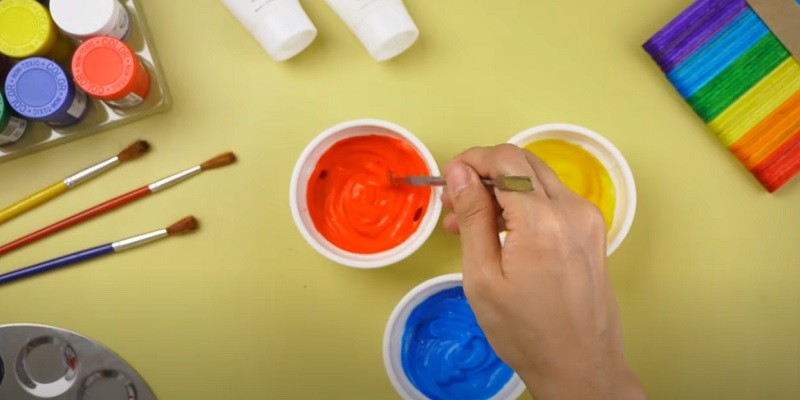Is Tempera Paint Safe For Skin?
Last Updated on June 18, 2025 by Jaclyn A. Neeley
When it comes to body art and face painting, the safety of the materials used is of utmost importance. Tempera paint, a popular choice for children’s art projects and classroom activities, is often questioned regarding its suitability for skin application. In this comprehensive article, we’ll explore the composition of tempera paint, its potential risks, and the best practices to ensure safe use on the skin.
Tempera Paint
Tempera paint is a water-based medium that consists of pigments, a binder, and other additives. Unlike traditional egg tempera, which uses egg yolk as the binder, modern tempera paints typically employ synthetic binders such as polyvinyl acetate or acrylics. This makes them more affordable, easier to produce, and less prone to spoilage.
Ingredients and Composition
The primary ingredients in tempera paint are:
- Pigments: These are the colored particles that give the paint its hue. Tempera paints often use a combination of inorganic and organic pigments, some of which may contain trace amounts of heavy metals like cadmium or lead.
- Binders: The binder is the substance that holds the pigment particles together and allows the paint to adhere to surfaces. Common binders used in tempera paints include polyvinyl acetate, acrylics, and cellulose derivatives.
- Additives: Tempera paints may also contain additives such as preservatives, thickeners, and surfactants to improve their performance and shelf life.
Potential Risks and Concerns
While tempera paints are generally considered non-toxic and safe for use on surfaces like paper, canvas, or wood, their suitability for skin application is a matter of debate. Here are some potential risks and concerns associated with using tempera paint on the skin:
Skin Irritation and Allergic Reactions
Some individuals may experience skin irritation or allergic reactions to certain ingredients in tempera paints, particularly pigments or preservatives. These reactions can range from mild redness and itching to more severe cases of rashes or swelling.
Heavy Metal Exposure
Certain pigments used in tempera paints, such as cadmium or lead-based colors, may contain trace amounts of heavy metals. While the levels are generally low, prolonged or excessive exposure to these heavy metals can be harmful, especially for children or pregnant women.
Ingestion Risks
Tempera paints are not intended for consumption, and ingesting them can lead to gastrointestinal issues or other health problems, particularly for young children who may accidentally ingest the paint during face painting or body art activities.
Best Practices for Safe Use
While tempera paints are not explicitly designed for skin application, they can be used safely with proper precautions and best practices. Here are some guidelines to follow:
Choose Reputable Brands
When selecting tempera paints for skin application, opt for reputable brands that clearly label their products as non-toxic and safe for use on the skin. Look for paints that are certified by organizations like the Art and Creative Materials Institute (ACMI) or the Toxic Substances Control Act (TSCA).
Perform Patch Tests
Before applying tempera paint to large areas of the skin, it’s essential to perform a patch test on a small, inconspicuous area. This will help identify any potential allergic reactions or sensitivities to the paint’s ingredients.
Avoid Sensitive Areas
Steer clear of applying tempera paint near the eyes, mouth, or other sensitive areas of the body. These areas are more prone to irritation and accidental ingestion.
Use Proper Application Techniques
When applying tempera paint to the skin, use clean brushes or sponges specifically designed for body art. Avoid using your fingers or hands, as this can increase the risk of ingestion or transferring bacteria to the paint.
Remove Paint Promptly
Tempera paint is designed to be water-soluble, making it easier to remove from the skin. However, it’s best to remove the paint promptly after use, especially for children or individuals with sensitive skin. Use mild soap and warm water to gently wash off the paint.
Supervise Children
When using tempera paints for children’s face painting or body art activities, ensure proper adult supervision at all times. This will help prevent accidental ingestion or misuse of the paints.
Alternatives to Tempera Paint
If you have concerns about using tempera paint on the skin, there are alternative options specifically designed for body art and face painting:
- Face Paints: These are cosmetic-grade paints formulated explicitly for use on the skin. They are typically non-toxic, hypoallergenic, and easy to remove.
- Henna: Henna is a natural, plant-based dye that has been used for centuries in body art and temporary tattoos. It is generally safe for skin application, but it’s essential to use high-quality, pure henna products.
- Makeup and Cosmetics: Certain types of makeup, such as cream-based or water-activated cosmetics, can also be used for body art and face painting. However, it’s crucial to ensure that the products are intended for skin application and are not expired or contaminated.
Conclusion
While tempera paints are generally considered non-toxic and safe for use on surfaces like paper or canvas, their suitability for skin application is a matter of debate. With proper precautions, such as choosing reputable brands, performing patch tests, and following best practices for application and removal, tempera paints can be used safely on the skin for body art and face painting activities.
However, it’s essential to be aware of the potential risks, such as skin irritation, allergic reactions, and ingestion hazards, especially when working with children or individuals with sensitive skin. If you have concerns or doubts, it’s always best to opt for products specifically designed for body art and face painting, such as cosmetic-grade face paints or natural alternatives like henna.
Ultimately, the safety of the materials used should be the top priority when engaging in body art or face painting activities. By following proper guidelines and exercising caution, you can enjoy the creative expression of these art forms while minimizing potential health risks.
FAQs
Can you paint your skin with tempera paint?
Tempera paint is not recommended for painting on the skin. Although it is non-toxic and safe for children, it is not formulated for skin application and may cause irritation or allergic reactions. For body painting, it is best to use paints specifically designed for skin, such as body or face paints, which are tested for safety and skin compatibility.
What kind of paint is safe for the skin?
The safest paints for skin are those specifically formulated for body use, such as water-based body paints, face paints, and henna. These paints are non-toxic, free from harsh chemicals, and designed to be gentle on the skin. Always check for labels indicating they are safe for the skin and perform a patch test to ensure no allergic reactions occur.
Is tempera paint safe for finger painting?
Yes, tempera paint is safe for finger painting. It is non-toxic, water-based, and designed for use by children, making it a popular choice for finger painting activities. Its creamy consistency and vibrant colors make it ideal for young artists to explore their creativity safely.
Is tempera paint easy to wash off skin?
Tempera paint is generally easy to wash off the skin, especially when it is still wet. It can be removed with soap and water. However, once dried, it may require additional methods such as using baby oil, mineral oil, or a gentle scrub to fully remove any remaining paint.
How should you clean tempera paint off the skin?
To clean tempera paint off the skin, start by washing the area with soap and warm water. If the paint has dried, apply a few drops of baby oil or mineral oil and gently scrub the area. For stubborn paint, you can use a loofah or scrub brush. Rinse thoroughly and repeat as necessary until all paint is removed.







